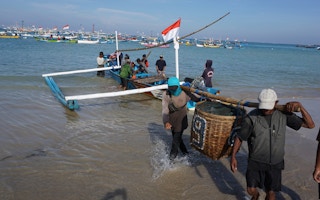Dubbed the “Great Garuda” megaproject — part of the National Capital Integrated Coastal Development plan — aims to build a giant sea wall to protect the Indonesian capital from floods and create 17 artificial islands that will be sold to private buyers.
The plan remains on track despite a moratorium imposed this month on the project because of graft charges against a city official and for reported lack of environmental analysis.
Experts warn that the project will cause irreversible damage to the marine ecosystem in Jakarta Bay while benefiting only a wealthy few.
Muhamad Karim, director of the Centre for Ocean Development and Maritime Civilisation (COMMIT), a local NGO, says the project encroaches on Jakarta’s poorest region and threatens the livelihoods of poor fishermen.
It will also take away US$376 million in economic and ecological benefits produced by the marine ecosystem in Jakarta Bay.
“
This is a serious issue not only for the environment but also for the economy because it deals with 24,000 traditional fishermen.
Muhammad Karim, director, Centre for Ocean Development and Maritime Civilisation
“If the reclamation continues, we will lose US$150 million from the damaged seagrass beds, US$150 million from the damaged coral reefs, and the rest of the losses will come from the damaged mangroves,” Karim tells SciDev.Net. “This is a serious issue not only for the environment but also for the economy because it deals with 24,000 traditional fishermen.”
Karim says the reclamation will affect the dynamic ecosystems in the Jakarta Bay area, including those that are now being rehabilitated.
The project will dig the sediments out from the bottom of the sea which will decrease sea water clarity and damage coral reefs and seagrass beds that serve as homes for fishes, sea cucumbers, crustaceans, manatees and many other marine animals.
Karim recommends that the government should instead undertake coastline rehabilitation, including mangrove restoration and coastal development.
“Mangroves are beneficial to the ecosystem because they protect the coasts by weakening wave energy and providing shelter for diverse marine biotas. The welfare of traditional fishermen should also be considered by raising the level of sanitation in the region. Both are more important than continuing the reclamation,” says Karim.
Karim’s data and recommendations were cited by local media outlets. Aside from the scientists, the project has also met opposition from the Ministry of Fisheries and Marine Affairs and the Ministry of Forestry and Environmental Affairs.
However, an account named elangk98 in Kompasiana, a popular social-blogging site in Indonesia, contends that the marine ecosystems in Jakarta Bay have already been polluted so badly that these are unlikely to possess enormous economic benefits.
“According to Jakarta’s Health Agency, the fishes in Jakarta Bay have been highly contaminated by heavy metals (1-1.5 gr/ppm) far above the safety limit (0.03 gr/ppm). If we maintain the current condition of this area, the million dollar loss will be smaller than the amount of money needed to cure cancers derived from contaminated fish consumption,” says the blogger.
This story was republished with permission from SciDev.net.








